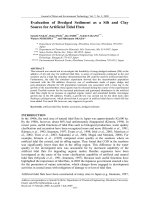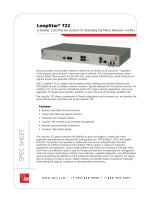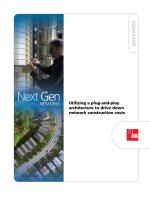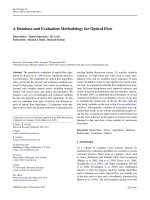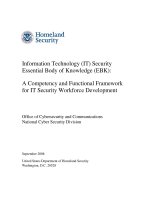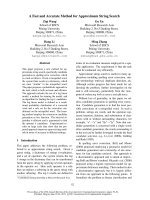a flexible and expandable architecture for computer games - thesis with appendix
Bạn đang xem bản rút gọn của tài liệu. Xem và tải ngay bản đầy đủ của tài liệu tại đây (3.77 MB, 412 trang )
A FLEXIBLE AND EXPANDABLE ARCHITECTURE
FOR COMPUTER GAMES
by
Jeff Plummer
A Thesis Presented in Partial Fulfillment
of the Requirements for the Degree of
Master of Science
ARIZONA STATE UNIVERSITY
December 2004
A FLEXIBLE AND EXPANDABLE ARCHITECTURE
FOR COMPUTER GAMES
by
Jeff Plummer
has been approved
November 2004
APPROVED:
, Chair
Supervisory Committee
ACCEPTED:
Department Chair
Dean, Division of Graduate Studies
ABSTRACT
Computer games have grown considerably in scale and complexity since their
humble beginnings in the 1960s. Modern day computer games have reached incredible
levels of realism, especially in areas like graphics, physical simulation, and artificial
intelligence. However, despite significant advances in software engineering, the
development of computer games generally does not employ state-of-the-art software
engineering practices and tools.
This thesis describes an architecture for computer games as a System of Systems
where the computer game itself is emergent. The proposed architecture follows a data
centered framework where the independent components collaborate on a central data
store. The architecture offers capabilities that are essential in overcoming challenges
faced in building computer games that can enjoy modifiability, expandability, and
maintainability traits. The architecture promotes component-based development (e.g.,
commercial off the shelf components) since the collaborating components have loose
couplings, which in turn facilitates systematic design integration of System of Systems.
iii
TABLE OF CONTENTS
Page
LIST OF FIGURES xxiii
CHAPTER
1 INTRODUCTION 1
1.1 Motivation 1
1.1.1 The current Approach and Its Shortcomings 1
1.1.2 The Migration to COTS 4
1.1.3 Not a Game Engine 5
1.2 High Level Objectives and Goals 6
1.2.1 Architectural Requirement: Support COTS-Based Development 7
1.2.2 Architectural Requirement: Better Knowledge Localization 7
1.2.3 Architectural Requirement: Flexibility / Modifiability 8
1.2.4 Architectural Requirement: Expandability / Maintainability 9
1.2.5 Performance and Other Quality Attributes are NOT requirements 9
1.3 Contributions 10
2 LITERATURE REVIEW 11
2.1 Current State of Game Development in Literature 11
2.2 The Latest Book Trends in Game Development 13
2.3 The First and Only Real Attempt at Game Architecture 14
iv
CHAPTER Page
v
2.4 Software Architecture 15
3 THESIS METHODOLOGY 17
3.1 Analysis of Games as Software Systems 18
3.1.1 Selecting Games to Analyze 18
3.1.1.1 Existing Game Genres 19
3.1.1.2 Further Refinement – Isolate Important Properties 21
3.1.2 The Selected Games for Analysis 23
3.1.3 Analyzing the Games 27
3.1.3.1 Analyzing Starcraft™ Requirements with Use-Cases 27
3.1.3.2 Understanding the Sub-System Interaction 30
3.2 Identify Candidate Architectural Styles 32
3.2.1 Layered 32
3.2.2 Data-Centered 32
3.2.3 Independent Components 33
3.2.4 Data Flow 33
3.2.5 System of Systems 33
3.3 Architecture Design 34
3.3.1 Choosing a Topology 34
3.3.1.1 Layered Architectural Style 35
3.3.1.2 Data Flow Architectural Style 36
3.3.1.3 Data Centered Architectural Style 38
3.3.1.4 Independent Components Architectural Style 40
CHAPTER Page
vi
3.3.1.5 System of Systems 42
3.3.2 Making the Topology Choice 43
3.3.3 Choosing a Style of Communication 45
3.3.3.1 Repository 45
3.3.3.2 Blackboard 46
3.3.3.3 Making the Communications Choice 47
3.3.4 Synchronicity 47
3.3.4.1 Synchrous at the Object Level 47
3.3.4.2 Batch Synchronization 48
3.3.4.3 Hybrid Synchronization 48
3.3.4.4 Making the Synchronicity Choice 48
3.4 The Idea – System of Systems Philosophy 49
4 THE PROPOSED ARCHITECTURE (and a Simple Design) 50
4.1 The Data-Centered System of Systems Topology 50
4.2 Architecture – System Communication 53
4.3 Architecture – Synchronization 54
4.4 Architecture – Distributed Synchronization 55
4.5 Architectural Features / Architectural Requirements 58
4.5.1 Support for COTS-Based Development 58
4.5.2 Better Knowledge Localization 58
4.5.3 System Flexibility / Modifiability 58
CHAPTER Page
vii
4.5.4 System Expandability / Maintainability 59
4.6 A Simple Design 60
4.6.1 Potential Design: System Communication / Interaction 60
4.6.2 Potential Design Cont.: Attaching Systems at Compile Time 61
4.6.3 Potential Design Cont.: System Communication 63
4.6.4 Potential Design Cont.: Observer Pattern to Achieve Localization of
Domain Knowledge
65
5 ARCHITECTURE VALIDATION 68
5.1 Taking the Reference Games to the Design Level 68
5.1.1 Applying the Design 68
5.1.2 Evaluating the results of applying the design 73
5.2 Developing a Prototype 74
5.2.1 Prototype High Level Design 74
5.2.1.1 Component Selection 74
5.2.1.2 The Object Data 76
5.2.2 Prototype Detailed Design 77
5.2.2.1 Component Interfaces 78
5.2.2.2 Domain-specific System – Object System Interactions 81
5.2.2.2.1 Connecting Domain System to the Object System 81
5.2.2.2.2 “Ticking” the Domain-specific System 82
5.2.3 Prototype Evaluation 83
CHAPTER Page
viii
6 RESULTS 85
6.1 Summary 85
6.2 Conclusions – Meeting The Architectural Requirements 86
6.2.1 Support COTS-Based Development 87
6.2.2 Better Knowledge Localization 87
6.2.3 Flexibility / Modifiability 88
6.2.4 Expandability / Maintainability 88
6.2.5 The Performance Concern 89
6.3 Important Considerations 90
6.3.1 Design is Critical 90
6.3.2 Central Object Management System = VERY different 91
6.3.3 Think about the Data 92
6.4 Future Research 93
6.4.1 Can this Architecture Work for Massively Multiplayer Online Games 93
6.4.2 Design: Domain-specific Component Connection to the Object
Management Component
93
6.4.3 Design: No More Interfaces to Access Object Data (If performance
allows)
94
6.4.4 Architecture Inside the Components 94
6.4.5 What is messaging overhead for independent component style 94
6.4.6 The Architectural Tradeoff Analysis Method……………………………95
CHAPTER Page
ix
Works Cited 96
APPENDIX Page
x
APPENDIX A - GAME ANALYSES 99
A - 1.1 Game Analysis 107
A - 1.1.1 Game Analysis - Use Case and Dynamic View 107
A - 1.1.1.1.1.1.1.1.1 Player 107
A - 1.1.1.1.1.1.1.1.2 System 107
A - 1.1.1.1.1.1.1.1.3 System (Ticked) 108
A - 1.1.1.2 Modules 109
A - 1.1.1.2.1 Game Data 110
A - 1.1.1.2.2 Game Logic 110
A - 1.1.1.2.3 Technology Modules 110
A - 1.1.1.2.3.1 AI 110
A - 1.1.1.2.3.2 Audio 110
A - 1.1.1.2.3.3 Graphics 110
A - 1.1.1.2.3.4 Network 110
A - 1.1.1.2.3.5 Physics 110
A - 1.1.1.2.3.6 User Interface 110
A - 1.1.1.3 Starcraft 111
A - 1.1.1.3.1 Use Cases 111
A - 1.1.1.3.1.1 Startup 112
A - 1.1.1.3.1.1.1.1.1 Select Multi-Player Game 112
A - 1.1.1.3.1.1.1.1.2 Select Single Player Game 112
A - 1.1.1.3.1.2 Options Menu 114
A - 1.1.1.3.1.2.1.1.1 End Mission 114
APPENDIX Page
xi
A - 1.1.1.3.1.2.1.1.2 Get Help 115
A - 1.1.1.3.1.2.1.1.3 Get Mission Objective 115
A - 1.1.1.3.1.2.1.1.4 Load Game 115
A - 1.1.1.3.1.2.1.1.5 Modify Options 115
A - 1.1.1.3.1.2.1.1.6 Return To Game 115
A - 1.1.1.3.1.2.1.1.7 Save Game 116
A - 1.1.1.3.1.3 Play Starcraft 117
A - 1.1.1.3.1.3.1.1.1 Attack Unit 117
A - 1.1.1.3.1.3.1.1.2 Change Map Display Area 123
A - 1.1.1.3.1.3.1.1.3 Gather Resources 126
A - 1.1.1.3.1.3.1.1.4 Give unit an order 132
A - 1.1.1.3.1.3.1.1.5 Move to Location 137
A - 1.1.1.3.1.3.1.1.6 Research Technology 142
A - 1.1.1.3.1.3.1.1.7 Select Object 145
A - 1.1.1.3.1.3.1.1.8 Building construct Unit 150
A - 1.1.1.3.1.3.1.1.9 Give Building an order 150
A - 1.1.1.3.1.3.1.1.10 Hold Position 150
A - 1.1.1.3.1.3.1.1.11 Manipulate Object Resources 151
A - 1.1.1.3.1.3.1.1.12 Manipulate Player Resources 151
A - 1.1.1.3.1.3.1.1.13 Modify Doable Commands 151
A - 1.1.1.3.1.3.1.1.14 Patrol Location 151
A - 1.1.1.3.1.3.1.1.15 Stop Movement 151
A - 1.1.1.3.1.3.1.1.16 Unit Construct Building 151
APPENDIX Page
xii
A - 1.1.1.3.1.4 Design: Tick Starcraft System 153
A - 1.1.1.3.1.4.1.1.1 Tick Starcraft Game System 154
A - 1.1.1.3.1.4.2 Tick AI System 155
A - 1.1.1.3.1.4.2.1.1 Tick AI System 155
A - 1.1.1.3.1.4.2.1.2 Navigate Map - Pathfinding 157
A - 1.1.1.3.1.4.2.1.3 Attack 158
A - 1.1.1.3.1.4.2.1.4 Calculate AI State 158
A - 1.1.1.3.1.4.2.1.5 Calculate Next Movement 159
A - 1.1.1.3.1.4.2.1.6 Calculate unit action 159
A - 1.1.1.3.1.4.2.1.7 Execute Map Watcher 159
A - 1.1.1.3.1.4.3 Tick Audio System 161
A - 1.1.1.3.1.4.3.1.1 Tick Audio System 161
A - 1.1.1.3.1.4.4 Tick Graphics System 164
A - 1.1.1.3.1.4.4.1.1 :IGraphicsObjectSystem 164
A - 1.1.1.3.1.4.4.1.2 Update View Object 164
A - 1.1.1.3.1.4.4.1.3 Tick Graphics System 166
A - 1.1.1.3.1.4.4.1.4 Update View 166
A - 1.1.1.3.1.4.4.1.5 Update Main View 171
A - 1.1.1.3.1.4.4.1.6 Draw Main View Objects 171
A - 1.1.1.3.1.4.4.1.7 Draw Main View Terrain 171
A - 1.1.1.3.1.4.4.1.8 Update All Views 171
A - 1.1.1.3.1.4.4.1.9 Update Command Button View 171
A - 1.1.1.3.1.4.4.1.10 Update Mini Map View 172
APPENDIX Page
xiii
A - 1.1.1.3.1.4.4.1.11 Update Protrait View 172
A - 1.1.1.3.1.4.4.1.12 Update Status View 172
A - 1.1.1.3.1.4.5 Tick Network Component 173
A - 1.1.1.3.1.4.5.1.1 Broadcast local objects TO server 173
A - 1.1.1.3.1.4.5.1.2 Tick Network System 173
A - 1.1.1.3.1.4.5.1.3 Update objects FROM server 175
A - 1.1.1.3.1.4.6 Tick Object Component 176
A - 1.1.1.3.1.4.6.1.1 Tick Object System / Game Logic 176
A - 1.1.1.3.1.4.6.1.2 Update Commander Object 178
A - 1.1.1.3.1.4.6.1.3 Update Controlled Object 178
A - 1.1.1.3.1.4.7 Tick UI Component 179
A - 1.1.1.3.1.4.7.1.1 Process Keyboard 179
A - 1.1.1.3.1.4.7.1.2 Process Mouse 179
A - 1.1.1.3.1.4.7.1.3 Tick User Interface 179
A - 1.1.1.4 Unreal Tournament 182
A - 1.1.1.4.1 Use Cases 182
A - 1.1.1.4.1.1 Play Unreal Tournament 183
A - 1.1.1.4.1.1.1.1.1 Collect Ammo 183
A - 1.1.1.4.1.1.1.1.2 Collect Health 183
A - 1.1.1.4.1.1.1.1.3 Collect Item 183
A - 1.1.1.4.1.1.1.1.4 Collect Weapon 185
A - 1.1.1.4.1.1.1.1.5 Jump 185
A - 1.1.1.4.1.1.1.1.6 Move 185
APPENDIX Page
xiv
A - 1.1.1.4.1.1.1.1.7 Rotate 187
A - 1.1.1.4.1.1.1.1.8 Shoot 187
A - 1.1.1.4.1.2 Design: Tick 188
A - 1.1.1.4.1.2.1.1.1 System (Ticked) 188
A - 1.1.1.4.1.2.1.1.2 Tick Physics Component 189
A - 1.1.1.4.1.2.1.1.3 Tick AI System 189
A - 1.1.1.4.1.2.1.1.4 Tick Audio Component 189
A - 1.1.1.4.1.2.1.1.5 Tick Graphics 3D Component 189
A - 1.1.1.4.1.2.1.1.6 Note 189
A - 1.1.1.4.1.2.1.1.7 Tick Network Component 190
A - 1.1.1.4.1.2.1.1.8 Tick Unreal Tournament Game System 190
A - 1.1.1.4.1.2.2 Tick AI System 191
A - 1.1.1.4.1.2.2.1.1 Tick Unreal Tournament Game System 191
A - 1.1.1.4.1.2.2.1.2 System (Ticked) 191
A - 1.1.1.4.1.2.2.1.3 Note 191
A - 1.1.1.4.1.2.2.1.4 Tick AI System 191
A - 1.1.1.4.1.2.2.1.5 Tick Player 193
A - 1.1.1.4.1.2.2.1.6 Tick Projectile 193
A - 1.1.1.4.1.2.3 Tick Audio Component 194
A - 1.1.1.4.1.2.3.1.1 Tick Audio Component 194
A - 1.1.1.4.1.2.4 Tick Graphics 3D Component 196
A - 1.1.1.4.1.2.4.1.1 Tick Graphics 3D Component 196
A - 1.1.1.4.1.2.4.1.2 Update All Graphical Views 198
APPENDIX Page
xv
A - 1.1.1.4.1.2.4.1.3 Update Character Status Overlay 198
A - 1.1.1.4.1.2.4.1.4 Update GUI Overlays 198
A - 1.1.1.4.1.2.4.1.5 Update Main Play View 198
A - 1.1.1.4.1.2.4.1.6 Update Team Score Overlay 200
A - 1.1.1.4.1.2.4.1.7 Update Weapon/Ammo Overlay 200
A - 1.1.1.4.1.2.5 Tick Network Component 201
A - 1.1.1.4.1.2.5.1.1 Broadcast Local Objects TO Server 201
A - 1.1.1.4.1.2.5.1.2 Tick Network Component 201
A - 1.1.1.4.1.2.5.1.3 Update Local Objects FROM Server 203
A - 1.1.1.4.1.2.6 Tick Object Component 204
A - 1.1.1.4.1.2.6.1.1 Tick Object Component 204
A - 1.1.1.4.1.2.7 Tick Physics Component 207
A - 1.1.1.4.1.2.7.1.1 Calculate Collision Reaction 207
A - 1.1.1.4.1.2.7.1.2 Detect Collisions 207
A - 1.1.1.4.1.2.7.1.3 Tick Physics Component 207
APPENDIX B – PROTOTYPE DESIGN 210
B - 1.2 Prototype 218
B - 1.2.1 Analysis View 218
B - 1.2.1.1 Logical Architecture 218
B - 1.2.1.1.1 Object Interfaces 219
B - 1.2.1.1.1.1.1.1.1 GameObject 219
B - 1.2.1.1.1.1.1.1.2 AI2Object 220
B - 1.2.1.1.1.1.1.1.3 IAIObject 220
APPENDIX Page
xvi
B - 1.2.1.1.1.1.1.1.4 IGraphics2DObject 220
B - 1.2.1.1.1.1.1.1.5 IGraphics3DObject 221
B - 1.2.2 Logical View 222
B - 1.2.2.1 Programming Utilities Library 222
B - 1.2.2.2 Systems 223
B - 1.2.2.1.2 AI System 224
B - 1.2.2.1.1 AI Component - Implementation 224
B - 1.2.2.2.1.1.1 AI Exported Classes 225
B - 1.2.2.2.1.1.1.1.1 Root 225
B - 1.2.2.2.1.1.2 Private AI System Implementation 227
B - 1.2.2.2.1.1.2.1.1 CAISystem 227
B - 1.2.2.2.1.1.2.1.2 CAIProcessorObject 228
B - 1.2.2.2.1.1.2.1.3 CAIViewProcessor 229
B - 1.2.2.1.2 AI Component - Interfaces 231
B - 1.2.2.2.1.2.1 AI Interfaces Object System Can Use To Communicate
With AI System
232
B - 1.2.2.2.1.2.1.1.1 IAIProcessorObject 232
B - 1.2.2.2.1.2.1.1.2 IAISystem 232
B - 1.2.2.2.1.2.1.1.3 IAIViewProcessor 233
B - 1.2.2.2.1.2.2 AI Interfaces The Object System Implements 234
B - 1.2.2.2.1.2.2.1.1 IAICapableObject 234
B - 1.2.2.2.1.2.2.1.2 IAIObjectSystem 234
B - 1.2.2.2.1.2.2.1.3 IAIProcessableObject 235
APPENDIX Page
xvii
B - 1.2.2.2.1.2.2.1.4 IAISceneManager 236
B - 1.2.2.2.1.2.2.1.5 IAIView 236
B - 1.2.2.2.2 AI2System 238
B - 1.2.2.2.1 AI2 Component - Implementation 238
B - 1.2.2.2.2.1.1 AI2 Exported Classes 239
B - 1.2.2.2.2.1.1.1.1 Root 239
B - 1.2.2.2.2.1.2 Private AI2 System Implementation 241
B - 1.2.2.2.2.1.2.1.1 CAI2System 241
B - 1.2.2.2.2.1.2.1.2 CAI2ProcessorObject 242
B - 1.2.2.2.2.1.2.1.3 CAI2ViewProcessor 243
B - 1.2.2.2.2 AI2 Component - Interfaces 245
B - 1.2.2.2.2.2.1 AI2 Interfaces Object System Can Use To
Communicate With AI2 System
246
B - 1.2.2.2.2.2.1.1.1 IAI2ProcessorObject 246
B - 1.2.2.2.2.2.1.1.2 IAI2System 246
B - 1.2.2.2.2.2.1.1.3 IAI2ViewProcessor 247
B - 1.2.2.2.2.2.2 AI2 Interfaces The Object System Implements 248
B - 1.2.2.2.2.2.2.1.1 IAI2CapableObject 248
B - 1.2.2.2.2.2.2.1.2 IAI2ObjectSystem 248
B - 1.2.2.2.2.2.2.1.3 IAI2ProcessableObject 249
B - 1.2.2.2.2.2.2.1.4 IAI2SceneManager 250
B - 1.2.2.2.2.2.2.1.5 IAI2View 250
B - 1.2.2.3.2 Game Object System 252
APPENDIX Page
xviii
B - 1.2.2.3.1 Game Object Component - Implementation 252
B - 1.2.2.2.3.1.1 Game Object Component Exported Classes 252
B - 1.2.2.2.3.1.1.1.1 Root 252
B - 1.2.2.2.3.1.2 Private Game Object Component Implementation 254
B - 1.2.2.2.3.1.2.1.1 CDemoCamera 254
B - 1.2.2.2.3.1.2.1.2 CDemoGameObjectSystem 255
B - 1.2.2.2.3.1.2.1.3 CDemoMainView 259
B - 1.2.2.2.3.1.2.1.4 CDemoObject 259
B - 1.2.2.2.3.1.2.1.5 CDemoObjectSceneManager 265
B - 1.2.2.2.3.1.2.1.6 CDemoViewBaseClass 267
B - 1.2.2.2.3.1.2.1.7 CTriangleGameObject 273
B - 1.2.2.2.3.1.2.2 Data Structures 275
B - 1.2.2.2.3.1.2.2.1 demoPoint2i 275
B - 1.2.2.2.3.1.2.2.2 demoPoint3f 276
B - 1.2.2.2.3.1.2.2.3 demoRect 276
B - 1.2.2.3.2 Game Object Component - Interfaces 278
B - 1.2.2.2.3.2.1.1.1 IObjectSystem 278
B - 1.2.2.3.3 Component Attachings 279
B - 1.2.2.4.2 Game System 281
B - 1.2.2.2.4.1.1.1.1 CDemoApplication 281
B - 1.2.2.5.2 Graphic 3D System 284
B - 1.2.2.5.1 Graphics3DComponent - Implementation 284
B - 1.2.2.2.5.1.1 Exported Classes 285
APPENDIX Page
xix
B - 1.2.2.2.5.1.1.1.1 Root 285
B - 1.2.2.2.5.1.2 Private Graphics3D System Implementation 287
B - 1.2.2.2.5.1.2.1.1 CGraphics3DProcessorObject 287
B - 1.2.2.2.5.1.2.1.2 CGraphics3DSystem 288
B - 1.2.2.2.5.1.2.1.3 CGraphics3DViewProcessor 291
B - 1.2.2.5.2 Graphics3DComponent - Interfaces 293
B - 1.2.2.2.5.2.1 Interfaces the Object System can use to communicate
with the Graphics3D System
294
B - 1.2.2.2.5.2.1.1.1 IGraphics3DProcessorObject 294
B - 1.2.2.2.5.2.1.1.2 IGraphics3DSystem 295
B - 1.2.2.2.5.2.1.1.3 IGraphics3DViewProcessor 295
B - 1.2.2.2.5.2.2 Interfaces The Object System Implements 297
B - 1.2.2.2.5.2.2.1.1 IGraphics3DCamera 297
B - 1.2.2.2.5.2.2.1.2 IGraphics3DCapableObject 297
B - 1.2.2.2.5.2.2.1.3 IGraphics3DObjectSystem 298
B - 1.2.2.2.5.2.2.1.4 IGraphics3DProcessableObject 298
B - 1.2.2.2.5.2.2.1.5 IGraphics3DSceneManager 299
B - 1.2.2.2.5.2.2.1.6 IGraphics3DView 300
B - 1.2.2.6.2 Graphics 2D System 302
B - 1.2.2.6.1 Graphics Component - Implementation 302
B - 1.2.2.2.6.1.1 Exported Classes 303
B - 1.2.2.2.6.1.1.1.1 Root 303
B - 1.2.2.2.6.1.2 Private Graphics System Implementation 305
APPENDIX Page
xx
B - 1.2.2.2.6.1.2.1.1 CGraphicsProcessorObject 305
B - 1.2.2.2.6.1.2.1.2 CGraphicsSystem 308
B - 1.2.2.2.6.1.2.1.3 CGraphicsViewProcessor 310
B - 1.2.2.6.2 Graphics Component - Interfaces 312
B - 1.2.2.2.6.2.1 Interfaces Object System Can Use To Communicate
With Graphics System 313
B - 1.2.2.2.6.2.1.1.1 IGraphicsProcessorObject 313
B - 1.2.2.2.6.2.1.1.2 IGraphicsSystem 313
B - 1.2.2.2.6.2.2 Interfaces The Object System Implements 315
B - 1.2.2.2.6.2.2.1.1 I2DGraphicsCamera 315
B - 1.2.2.2.6.2.2.1.2 I2DGraphicsObject 316
B - 1.2.2.2.6.2.2.1.3 I2DSpriteGraphicsObject 316
B - 1.2.2.2.6.2.2.1.4 IGraphicsCamera 317
B - 1.2.2.2.6.2.2.1.5 IGraphicsCapableObject 317
B - 1.2.2.2.6.2.2.1.6 IGraphicsObjectIterator 317
B - 1.2.2.2.6.2.2.1.7 IGraphicsObjectSystem 318
B - 1.2.2.2.6.2.2.1.8 IGraphicsSceneManager 318
B - 1.2.2.2.6.2.2.1.9 IGraphicsView 319
B - 1.2.2.2.6.2.2.1.10 IGraphicsViewIterator 320
B - 1.2.2.2.6.2.2.1.11 IProcessableGraphicsObject 321
B - 1.2.2.3 Utility Includes 323
B - 1.2.2.3.1.1.1.1.1 CStdStr 323
B - 1.2.2.3.1.1.1.1.2 IIterator 334
APPENDIX Page
xxi
B - 1.2.2.3.1.1.1.1.3 VectorBasedIteratorTemplateClass 335
B - 1.2.3 Dynamic View 337
B - 1.2.3.1 Initialize 337
B - 1.2.3.1.1.1.1.1.1 Initialize AI2 System 337
B - 1.2.3.1.1.1.1.1.2 Initialize AI System 340
B - 1.2.3.1.1.1.1.1.3 Initialize Graphics 3D System 343
B - 1.2.3.1.1.1.1.1.4 Initialize Graphics System 346
B - 1.2.3.1.1.1.1.1.5 Initialize Object System 350
B - 1.2.3.1.1.1.1.1.6 Initialize Game System 353
B - 1.2.3.2 Tick 356
B - 1.2.3.2.1.1.1.1.1 Tick AI System 356
B - 1.2.3.2.1.1.1.1.2 Tick AI2 System 362
B - 1.2.3.2.1.1.1.1.3 Tick Graphics 3D System 367
B - 1.2.3.2.1.1.1.1.4 Tick Graphics System 373
B - 1.2.3.2.1.1.1.1.5 Tick Prototype Game System 379
B - 1.2.4 Component View 380
B - 1.2.4.1.1.1.1.1.1 AI System 2 380
B - 1.2.4.1.1.1.1.1.2 Artificial Intelligence 380
B - 1.2.4.1.1.1.1.1.3 Audio 380
B - 1.2.4.1.1.1.1.1.4 Game System 380
B - 1.2.4.1.1.1.1.1.5 Graphics 381
B - 1.2.4.1.1.1.1.1.6 Graphics 3D System 381
B - 1.2.4.1.1.1.1.1.7 Network 381
APPENDIX Page
xxii
B - 1.2.4.1.1.1.1.1.8 Object & Object Management System (Data)
381
B - 1.2.4.1.1.1.1.1.9 OGRE Graphics Engine 381
B - 1.2.4.1.1.1.1.1.10 Physics Component 382
B - 1.2.4.1.1.1.1.1.11 User Interface 382
xxiii
LIST OF FIGURES
Figure Page
1 - Rollings’ and Morris’ Game Architecture 2
2 - Object Centric View of Games 4
3 - Current Object Centered COTS Approach 5
4 - Object/Class Level Separation of Logic 12
5 Rollings’ and Morris’ Game Architecture 15
6 - Screenshot from the Game Starcraft 24
7 - Screenshot from Unreal Tournament 26
8 - Screenshot Unreal Tournament 2004 26
9 - Playing Starcraft Use Case Diagram 28
10 - Logical Modules 29
11 - Select Object (Subsystem interactions) 31
12- A Simple Layered Architecture 35
13- Data Flow 37
14- Data Flow at the Component Level (AI) 38
15 – Data Centered 39
16 – Select Object (Logical Module Interactions – Data Centered) 40
17- Independent Components 42
18 - Layered and Data-Centered 45
19 - Repository 46
20 - Data Centered System of Systems 51
Figure Page
xxiv
21- Intelligent Data System Centered System of Systems 52
22 – System Defined as a Domain-specific Component & the Object Component 53
23 - Ticking the Game System of Systems 55
24 – Example Peer to Peer Networked Game 56
25 -Example Client Server Networked Game 57
26- Potential Design using many AI Systems 59
27 – Interfaces Required to Connect Domain-specific Component to the Object
Management Component
62
28 – Example Sequence of Connecting a Domain-specific Component to the Object
Management Component
62
29 – Interfaces Required for Domain-specific System To Request Objects to Process 64
30 – Example Sequence of a Domain-specific System Requesting Objects to Process 65
31-Potential Design using a Domain Observer Object 66
32-Potential Sequence using a Domain Observer Object 67
33 - Tick Game System Use Case 70
34 – Tick Graphics System 71
35 – Update View Component Sequence 72
36 – Update View – Classes and Interfaces 73
37 – Prototype Subsystems 75
38 – Analysis of Object Data Required 77
39 - Example: Graphics3D System Interfaces 79
40 – Interfaces Into the Graphics 3D System 80
Figure Page
xxv
41 – Interfaces the Object and Object Management System Must Implement in order for
the Graphics 3D Component to Use it.
81
42 – Connecting the Object Component to the Graphics3D Component 82
43 – Prototype Sequence: Tick Graphics2D System 83
44 – Screenshot1 from Prototype 84
45 - Screenshot 2 from Prototype 84
46 : Analysis 107
47 : Logical Modules 109
48 : Use Case Model 111
49 : Startup 112
50 : Options Menu 114
51 : Play Starcraft 117
52 : Analysis: Attack Unit (Logical Modules Involved) 118
53 : Design: Attack Unit (Component Sequence) 121
54 : Analysis: Change Map Display Area by Moving Mouse to Edge of Screen(Logical
Modules Involved)
124
55 : Design: Change Map Display Area (Component Sequence) 125
56 : Analysis: Gather Resources (Logical Modules Involved) 127
57 : Design: Gather Resources (Component Sequence) 130
58 : Analysis: Give unit an order by clicking order button (Logical Modules Involved)133
59 : Design: Give unit an order (Component Sequence) 135
60 : Analysis: Move to Location (Sub-system Interactions) 137
61 : Design: Move to Location (Component Sequence) 140
